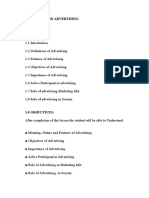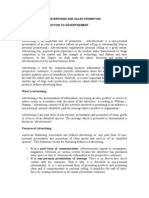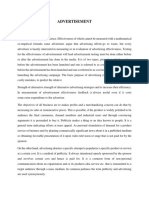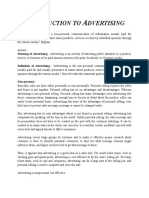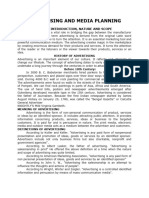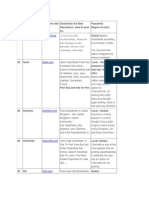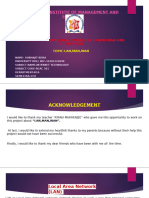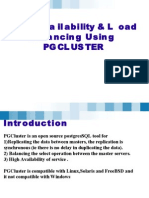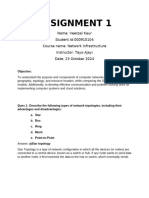Advertising Is Nothing But A Paid Form of Non
Advertising Is Nothing But A Paid Form of Non
Uploaded by
Pamei DngCopyright:
Available Formats
Advertising Is Nothing But A Paid Form of Non
Advertising Is Nothing But A Paid Form of Non
Uploaded by
Pamei DngOriginal Title
Copyright
Available Formats
Share this document
Did you find this document useful?
Is this content inappropriate?
Copyright:
Available Formats
Advertising Is Nothing But A Paid Form of Non
Advertising Is Nothing But A Paid Form of Non
Uploaded by
Pamei DngCopyright:
Available Formats
Advertising Advertising is nothing but a paid form of non-personal presentation or promotion of ideas, goods or services by an identified sponsor with
a view to disseminate information concerning an idea, product or service. The message which is presented or disseminated is called advertisement. In the present day marketing activities hardly is there any business in the modern world which does not advertise. However, the form of advertisement differs from business to business. Advertisement has been defined differently by different persons. A few definitions are being reproduced below: According to Wood, "Advertising is causing to know to remember, to do." According to Wheeler, "Advertising is any form of paid non-personal presentation of ideas, goods or services for the purpose of inducting people to buy." According to Richard Buskirk, "Advertising is a paid form of non-personal presentation of ideas, goods or services by an identified sponsor." According to William J. Stanton, "Advertising consists of all the activities involves in presenting to a group, a non-personal, oral or visual, openly sponsored message regarding disseminated through one or more media and is paid for by an identified sponsor." The above definitions clearly reveal the nature of advertisement. This is a powerful element of the promotion mix. Essentially advertising means spreading of information about the characteristics of the product to the prospective customers with a view to sell the product or increase the sale volume. The main features of advertise are as under: It is directed towards increasing the sales of business. Advertising is a paid form of publicity It is non-personal. They are directed at a mass audience and nor at the individual as is in the case of personal selling. Advertisements are identifiable with their sponsor of originator which is not always the case with publicity or propaganda. Objective / Functions of advertising The purpose of advertising is nothing but to sell something -a product, a service or an idea. The real objective of advertising is effective communication between producers and consumers. The following are the main objectives of advertising: Preparing Ground for New Product
New product needs introduction because potential customers have never used such product earlier and the advertisement prepare a ground for that new product. Creation of Demand The main objective of the advertisement is to create a favorable climate for maintaining of improving sales. Customers are to be reminded about the product and the brand. It may induce new customers to buy the product by informing them its qualities since it is possible that some of the customers may change their brands. Facing the Competition Another important objective of the advertisement is to face to competition. Under competitive conditions, advertisement helps to build up brand image and brand loyalty and when customers have developed brand loyalty, becomes difficult for the middlemen to change it. Creating or Enhancing Goodwill: Large scale advertising is often undertaken with the objective of creating or enhancing the goodwill of the advertising company. This, in turn, increases the market receptiveness of the company's product and helps the salesmen to win customers easily. Informing the Changes to the Customers Whenever changes are made in the prices, channels of distribution or in the product by way of any improvement in quality, size, weight, brand, packing, etc., they must be informed to the public by the producer through advertisement. Neutralizing Competitor's Advertising Advertising is unavoidable to complete with or neutralize competitor's advertising. When competitors are adopting intensive advertising as their promotional strategy, it is reasonable to follow similar practices to neutralize their effects. In such cases, it is essential for the manufacturer to create a different image of his product. Barring New Entrants From the advertiser's point of view, a strongly built image through long advertising helps to keep new entrants away. The advertisement builds up a certain monopoly are for the product in which new entrants find it difficult to enter. In short, advertising aims at benefiting the producer, educating the consumer and supplementing the salesmen. Above all it is a link between the producer and the consumer.
Benefits or Importance of Advertisement Advertising broadens the knowledge of the consumers. With the aid of advertising, consumers find and buy necessary products without much waste of time. This speeds up the sales of commodities, increases the efficiency of labor in distribution, and diminishes the costs of selling. It is an accepted fact that without market stimulus of heavy advertising, consumers might have waited another sixty years for the product evaluation that took place in less than ten years - it took after all over sixty years from the invention of the safety razor before the first acceptable stainless steel blades appeared in the market. These words are more than enough to testify the potentialities of advertising in the field of modern marketing system. The main benefits of advertising may be narrated as follows: Benefits to Manufacturers It increases sales volume by creating attraction towards the product. It helps easy introduction of new products into the markets by the same manufacturer. It helps to create an image and reputation not only of the products but also of the producer or advertiser. In this way, it creates goodwill for the manufacturer. Retail price, maintenance is also possible by advertising where price appeal is the promotional strategy. It helps to establish a direct contact between manufacturers and consumers. It leads to smoothen the demand of the product. It saves the product from seasonal fluctuations by discovering new and new usage of the product. It creates a highly responsive market and thereby quickens the turnover that results in lower inventory. Selling cost per unit is reduced because of increased sale volume. Consequently, product overheads are also reduced due to mass production and sale. Advertising gives the employees a feeling of pride in their jobs and to be in the service of such a concern of repute. It, thus inspires the executives and worker to improve their efficiency. Advertising is necessary to meet the competition in the market and to survive. Benefits to Wholesalers and Retailers Easy sale of the products is possible since consumers are aware of the product and its quality. It increases the rate of the turn-over of the stock because demand is already created by advertisement. It supplements the selling activities. The reputation created is shared by the wholesalers and retailers alike because they need not spend anything for the advertising of already a well advertised product. It ensures more economical selling because selling overheads are reduced. It enables them to have product information.
Benefits to Consumers Advertising stresses quality and very often prices. This forms an indirect guarantee to the consumers of the quality and price. Further large scale production assumed by advertising enables the seller to seller product at a lower cost. Advertising helps in eliminating the middlemen by establishing direct contacts between producers and consumers. It results in cheaper goods. It helps them to know where and when the products are available. This reduces their shopping time. It provides an opportunity to the customers to compare the merits and demerits of various substitute products. This is perhaps the only medium through which consumers could know the varied and new uses of the product. Modern advertisements are highly informative. Benefits to Salesmen Salesmanship is incomplete without advertising. Advertising serves as the forerunner of a salesman in the distribution of goods. Sales is benefited the advertisement in following ways: Introducing the product becomes quite easy and convenient because manufacturer has already advertised the goods informing the consumers about the product and its quality. Advertising prepares necessary ground for a salesman to begin his work effectively. Hence sales efforts are reduced. The contact established with the customer by a salesman is made permanent through effective advertising because a customer is assumed of the quality and price of the product. The salesman can weigh the effectiveness of advertising when he makes direct contact with the consumers. Benefits to Community or Society Advertising, in general, is educative in nature. In the words of the late President Roosevelt of the U.S.A., "Advertising brings to the greatest number of people actual knowledge concerning useful things: it is essentially a form of education and the progress of civilization depends on education." Advertising leads to a large-scale production creating more employment opportunities to the public in various jobs directly or indirectly. It initiates a process of creating more wants and their satisfaction higher standard of living. For example, advertising has made more popular and universal the uses of such inventions as the automobiles, radios, and various household appliances. Newspapers would not have become so popular and so cheap if there had been no advertisements. The cheap production of newspapers is possible only through the publication of advertisements in them. It sustains the press. It assures employment opportunities for the professional men and artist.
Advertising does provide a glimpse of a country's way of life. It is, in fact, a running commentary on the way of living and the behavior of the people and is also an indicator of some of the future in this regard.
Various media for Advertising Advertising media are the means to transmit the message of the advertiser to the desired class of people. Channels or vehicle by which an advertising message is brought to the notice of the prospective buyer: Types of Media There is no dearth of media today. It may be direct or indirect. Direct method of advertising refers to such methods used by the advertiser with which he could establish a direct contact with the prospective hand involve the use of a hired agency for spreading the information. Most of the media are indirect in nature, e.g., press publicity, cinema, etc. The various media that are commonly used are being explained here under: Newspapers Newspaper (Hindi or English) (morning or evening editions) are bought largely for their news value as such they are most appropriate for announcing new products and new development of existing products. The choice of a particular news paper for advertising depends upon many factors i.e., circulation of the newspaper, the type of readers it serves, the geographical region in which it is popular, the costs of space and general reputation of the paper etc. Magazines Another medium under press publicity is magazines and journals. They also offer good facility because magazine are read leisurely when the reader is mentally prepared to receive advertisements. Online advertisement Online advertising is a form of promotion that uses the Internet and World Wide Web to deliver marketing messages to attract customers. The internet has become an ongoing emerging source that tends to expand more and more. The growth of this particular medium attracts the attention of advertisers as a more productive source to bring in consumers. A clear advantage consumers have with online advertisement is the control they have over the product, choosing whether to check it out or not.
Online advertisements may also offer various forms of animation. In its most common use, the term "online advertising" comprises all sorts of banner, e-mail, in-game, and keyword advertising, on platforms such as Facebook, Twitter, or Myspace has received increased relevance. Web-related advertising has a variety of sites to publicize and reach a niche audience to focus its attention to a specific group. Research has proven that online advertising has given results and is growing business revenue. For the year 2012, Jupiter research predicted $34.5 billion in US online advertising spending. Online Ad - Competitive advantage over traditional advertising One major benefit of online advertising is the immediate publishing of information and content that is not limited by geography or time. To that end, the emerging area of interactive advertising presents fresh challenges for advertisers who have hitherto adopted an interruptive strategy. Another benefit is the efficiency of advertiser's investment. Online advertising allows for the customization of advertisements, including content and posted websites. For example, AdWords, Yahoo! Search Marketing and Google AdSense enable ads to be shown on relevant web pages or alongside search result
SEVEN BASIC STEPS IN PLANNING THE AD CAMPAIGN 1. Appraise your advertising opportunity: - Is there a favorable primary-demand for the product? Are people willing and able to purchase my product at a price that will return me a reasonable profit? - Are there opportunities for product differentiation? - Can I identify any hidden qualities which might serve as the focal point of an ad campaign? - Are there any powerful emotional buying motives attached to my product? - What proportion of the people can afford to buy my product and can I reach them with ads and product? 2. Analyze your market: - Do I have sufficient information to define closely the target market? - Am I aware of the factors of that affect demand for my product? - What do I suspect will be the competitive response to my ad campaign? - Are there any legal constraints surrounding my advertising certain products or services? - Can I afford advertising? If so, how much is appropriate considering my market situation? - Do I have the capabilities to produce sufficient volumes of my product if sales increase dramatically because of advertising? 3. Determine your advertising objectives -- should contain: - What is the basic message I want delivered? - Who is the audience I want reached? - What do I want to happen because of the ad campaign?
- What are the specific criteria which will be used to measure the success or failure of the campaign after it is completed? 4. Establish you budget and the necessary control systems: - What kind of balance between reach, frequency, and continuity will be most effective? **reach: total number of different people or households to whom your message is delivered; **frequency: number of times your message is delivered within a given period of time; **continuity: length of time your media schedule will run 5. Develop your strategy: - Which media will deliver the most effective advertising messages to the greatest number of prospects at the lowest possible cost? - What kind of message should be created? To answer this considers the following: 1) What business goals do you want to accomplish? 2) What kind of people do you now sell to? What kind of people should you be selling to? 3) How do people in your target market currently think, feel, and believe about your product, your company, and your competition? 4) What do you want these people to feel, think, and do? 5) What key thought can you put into these peoples' minds to make them think, feel, believe, or do what you would like? 6) What tone of voice will get those people to hear and believe you? - What is the basic theme that needs to be included as it appears, at least by implication, in all your ads and publicity. 6. Coordinate advertising with other promotional and marketing methods: - What other types of advertising and marketing efforts am I currently involved in? - How will these other activities affect my ad campaign? 7. Evaluate advertising results: - Have I done adequate pretesting before investing substantial money in a major campaign? - What criteria will I use to judge the effectiveness of my advertising expenditures after the campaign is completed? - What have I learned that will help insure that future campaigns will be more effective? The Advertising Planning Cycle Devised by Stephen King, the London based Advertising professional, the planning cycle is one of the most sound and simple ways to study how advertising campaigns are developed. The Advertising planning cycle helps in isolating the roles of each department in an agency such as Client Servicing, Creative, Media and Research. It guides the agency through various stages of formulating, creating, releasing and evaluating an advertising campaign. The first two questions are research based, the agency needs to find out how the brand is perceived, the current profile of its consumers and what trends are influencing the segment and the category.
The third question is answered based on the clients' objective and here the advertising strategy comes into the picture. Research is also carried out to generate and evaluate creative ideas. The fourth question, is concerned mostly with the creative process of planning and generating themes for the campaign. The media analysis and planning also plays a major role during this stage. The final stage involves evaluating the effect of the campaign in the marketplace, in order to improve upon it or provide guidance for new campaigns. And finally when this stage has been reached, its time to start the process again.
You might also like
- Phlebotomy HandbookDocument2 pagesPhlebotomy HandbookFaith Domingo67% (3)
- Aspm - NotesDocument10 pagesAspm - Noteschsureshkumar1985No ratings yet
- Content Marketing Strategy Template: (Insert Company Name)Document34 pagesContent Marketing Strategy Template: (Insert Company Name)S Cap100% (1)
- Media and Information SourcesDocument22 pagesMedia and Information SourcesJudy Tumarao LptNo ratings yet
- The Main Features of Advertise Are As UnderDocument5 pagesThe Main Features of Advertise Are As UnderdebasispahiNo ratings yet
- Chapter 1Document9 pagesChapter 1SaifullahMakenNo ratings yet
- Advertising & Media PlanningDocument44 pagesAdvertising & Media Planningsrisaidegree collegeNo ratings yet
- Minor 2 ADVERTISING DECISIONSDocument21 pagesMinor 2 ADVERTISING DECISIONSSanchit MahajanNo ratings yet
- Advertising and Sales PromotionDocument12 pagesAdvertising and Sales PromotionSandeep SinghNo ratings yet
- Introduction AdvertisingDocument82 pagesIntroduction AdvertisingselbalNo ratings yet
- Advertising and Sales PromotionDocument38 pagesAdvertising and Sales PromotionKavita Poddar100% (1)
- ASP NotesDocument73 pagesASP NotesChandrakant SinghNo ratings yet
- Marketing Project Report On Advertising EffectivenessDocument33 pagesMarketing Project Report On Advertising EffectivenessParteek MahajanNo ratings yet
- #15 AdvertisingDocument17 pages#15 AdvertisinggunflayercsgoNo ratings yet
- Full Project ReportDocument110 pagesFull Project Reporteswari100% (3)
- AanchalDocument27 pagesAanchalDinesh ChahalNo ratings yet
- Ntroduction TO DvertisingDocument20 pagesNtroduction TO DvertisingwaleedjuttNo ratings yet
- Project 1Document42 pagesProject 1Sanjib ChakrabortyNo ratings yet
- Project Report On Advertising EffectivenessDocument40 pagesProject Report On Advertising EffectivenessManish GandhiNo ratings yet
- Advertising Unit 1Document26 pagesAdvertising Unit 1Harshit KumarNo ratings yet
- Project Report - Advertising EffectivenessDocument15 pagesProject Report - Advertising EffectivenessAravind KumarNo ratings yet
- The Objectives of All Business Are To Makes Profits and A Merchandising Concern Can Do That by Increasing Its Sales at Remunerative PricesDocument15 pagesThe Objectives of All Business Are To Makes Profits and A Merchandising Concern Can Do That by Increasing Its Sales at Remunerative PricesKarthik Vijay0% (1)
- Project Report On Advertising EffectivenessDocument31 pagesProject Report On Advertising EffectivenessRahul ReddyNo ratings yet
- Advertizing and Media PlanningDocument51 pagesAdvertizing and Media Planningjaheershaik087No ratings yet
- 1.1 Introduction To AdvertisingDocument15 pages1.1 Introduction To AdvertisingAvni JainNo ratings yet
- Advertising Management NotesDocument24 pagesAdvertising Management NotesJikz ZatNo ratings yet
- Mehlams Marketing Appeal 2Document31 pagesMehlams Marketing Appeal 2Mehlam GhadyaliNo ratings yet
- Meaning of PromotionDocument6 pagesMeaning of PromotionSapkota ArjunNo ratings yet
- Remnault KwidDocument41 pagesRemnault KwidAmanNo ratings yet
- Project Report On Advertising EffectivenessDocument18 pagesProject Report On Advertising EffectivenessPriya SheoranNo ratings yet
- MBA Project Advertising EffectivenessDocument17 pagesMBA Project Advertising EffectivenessKuldeep Kaur SandhawaliaNo ratings yet
- Project Report On Advertising EffectivenessDocument40 pagesProject Report On Advertising EffectivenessAnonymous 8SNpyX100% (2)
- Suggested Project Topics For E-Supply Chain Management (Sec-I and Sec-II)Document9 pagesSuggested Project Topics For E-Supply Chain Management (Sec-I and Sec-II)surbhi bistNo ratings yet
- Advertising-Effectiveness Cold DrinkDocument42 pagesAdvertising-Effectiveness Cold Drinkjfdj_898jgkgfNo ratings yet
- Project Report On Advertising EffectivenessDocument18 pagesProject Report On Advertising EffectivenessvickyNo ratings yet
- Advertising Effectiveness Research ProjectDocument40 pagesAdvertising Effectiveness Research ProjectHemant Dhillon92% (12)
- Study Material English GeDocument187 pagesStudy Material English Gekamatsnk54No ratings yet
- Advertising EffectivenessDocument37 pagesAdvertising EffectivenessVipin Rawat100% (1)
- Apm MGTDocument30 pagesApm MGTMalathi Meenakshi SundaramNo ratings yet
- Unit 1Document40 pagesUnit 1Kp PrakashNo ratings yet
- Lect 7the Structure of The Advertising IndustryDocument40 pagesLect 7the Structure of The Advertising IndustryKashf ShabbirNo ratings yet
- Engj 1 5Document5 pagesEngj 1 5kusumNo ratings yet
- What Is Advertising PDFDocument201 pagesWhat Is Advertising PDFAngela Padua100% (3)
- 1.1 Outline of The ProjectDocument21 pages1.1 Outline of The ProjectMahendrakumar SubramaniNo ratings yet
- Advertisement Sales PromotionDocument58 pagesAdvertisement Sales PromotionBhavanya RavichandrenNo ratings yet
- Chapter 1.: Advertising. 1.1 Origin of AdvertisingDocument37 pagesChapter 1.: Advertising. 1.1 Origin of Advertisingsureh_mite_nitkyahooNo ratings yet
- Abm InternalDocument24 pagesAbm InternalDiksha YadvNo ratings yet
- What Is Advertising?: According To William J. Stanton, "Advertising Consists of All The ActivitiesDocument5 pagesWhat Is Advertising?: According To William J. Stanton, "Advertising Consists of All The ActivitiesJyoti100% (1)
- Chapter 1Document23 pagesChapter 1Aparna SureshNo ratings yet
- Notes B.com. (Prog.) Advertising, Personal SellingDocument8 pagesNotes B.com. (Prog.) Advertising, Personal Sellingmokshjain061No ratings yet
- Customer Loyalty: Customer Loyalty Is The Result of Consistently Positive EmotionalDocument9 pagesCustomer Loyalty: Customer Loyalty Is The Result of Consistently Positive EmotionalSundus ButtNo ratings yet
- Summary: Scientific Advertising: Review and Analysis of Hopkins' BookFrom EverandSummary: Scientific Advertising: Review and Analysis of Hopkins' BookRating: 5 out of 5 stars5/5 (1)
- Advertising Made Easy: How to Create Campaigns That Capture AttentionFrom EverandAdvertising Made Easy: How to Create Campaigns That Capture AttentionNo ratings yet
- Social Media Dominance: Social media marketing content strategy made simple.How to use social media for business strategy,the tools,campaigns & strategies for public relations& marketing professionalsFrom EverandSocial Media Dominance: Social media marketing content strategy made simple.How to use social media for business strategy,the tools,campaigns & strategies for public relations& marketing professionalsRating: 1 out of 5 stars1/5 (1)
- Social Media Marketing for Beginners 2025 The #1 Guide To Conquer The Social Media World, Make Money Online and Learn The Latest Tips On Facebook, Youtube, Instagram, Twitter & SEOFrom EverandSocial Media Marketing for Beginners 2025 The #1 Guide To Conquer The Social Media World, Make Money Online and Learn The Latest Tips On Facebook, Youtube, Instagram, Twitter & SEONo ratings yet
- How to Sell (eCommerce) - Marketing and Internet Marketing StrategiesFrom EverandHow to Sell (eCommerce) - Marketing and Internet Marketing StrategiesNo ratings yet
- The Modern Guide to Paid Advertising for Business Owners: A Quick-Start Introduction to Google, Facebook, Instagram, YouTube, and TikTok AdsFrom EverandThe Modern Guide to Paid Advertising for Business Owners: A Quick-Start Introduction to Google, Facebook, Instagram, YouTube, and TikTok AdsNo ratings yet
- How To Weed Out The Garbage When Marketing Your ProductFrom EverandHow To Weed Out The Garbage When Marketing Your ProductNo ratings yet
- Sales Promotion: All the tactics you need to turn an outbound prospect into a customerFrom EverandSales Promotion: All the tactics you need to turn an outbound prospect into a customerNo ratings yet
- Marketing Management for Beginners: How to Create and Establish Your Brand With the Right Marketing Management, Build Sustainable Customer Relationships and Increase Sales Despite a Buyer’s MarketFrom EverandMarketing Management for Beginners: How to Create and Establish Your Brand With the Right Marketing Management, Build Sustainable Customer Relationships and Increase Sales Despite a Buyer’s MarketNo ratings yet
- Google App Script TutorialDocument8 pagesGoogle App Script Tutorialashishkhurana93No ratings yet
- Top 10 Freelisting SitesDocument6 pagesTop 10 Freelisting SitesDev Ashwani100% (1)
- Ip2location Database InstructionsDocument3 pagesIp2location Database InstructionsRfadGrmmNo ratings yet
- 08 PHP MYSQL Complex Queries FunctionsDocument16 pages08 PHP MYSQL Complex Queries FunctionsGeshan Manandhar100% (6)
- Subhajit Kora (Bcac 501)Document10 pagesSubhajit Kora (Bcac 501)subhajitkora2004No ratings yet
- VRP-The Future of Network RoutingDocument2 pagesVRP-The Future of Network Routinghilbert69100% (1)
- Hig H Ava Il Ability & L Oad Balancingusing PgclusterDocument20 pagesHig H Ava Il Ability & L Oad Balancingusing PgclusterperlashokNo ratings yet
- TD-8840T V4 DatasheetDocument3 pagesTD-8840T V4 DatasheetFlorentina Indri PramestiNo ratings yet
- Google Africa Developer Scholarship 2022Document9 pagesGoogle Africa Developer Scholarship 2022No OneNo ratings yet
- Cyber SecurityDocument68 pagesCyber SecuritymoisertarienNo ratings yet
- Principles and Best Practices: O'Reilly RadarDocument9 pagesPrinciples and Best Practices: O'Reilly RadarRahul BhagatNo ratings yet
- How To Download Data Files From HTTP Service With WgetDocument5 pagesHow To Download Data Files From HTTP Service With WgetHenry EzeiloNo ratings yet
- HTTP Assessment - Netacad.net Virtuoso Delivery Pub-Doc Exam - shtml1Document4 pagesHTTP Assessment - Netacad.net Virtuoso Delivery Pub-Doc Exam - shtml1YemenStar00767% (3)
- Delhi Skill and Entrepreneurship UniversityDocument2 pagesDelhi Skill and Entrepreneurship Universityftdp11322020No ratings yet
- The Pirate Bay (E Commerce)Document36 pagesThe Pirate Bay (E Commerce)Mongkolchai CrsmNo ratings yet
- Assignment1 Network InfrastructureDocument20 pagesAssignment1 Network Infrastructurenavjothk4No ratings yet
- GizDuino Users ManualDocument13 pagesGizDuino Users ManualPatrick Bueno Lara100% (1)
- SAP Human Capital Management: Time Recording Using CATSDocument89 pagesSAP Human Capital Management: Time Recording Using CATSrajeevmenon2003No ratings yet
- AppManager User GuideDocument1,264 pagesAppManager User GuidePavan Sharma100% (1)
- Ethics in Domestic SurveillanceDocument11 pagesEthics in Domestic Surveillancehonbear4u2No ratings yet
- Modelling and Simulation Using MATLAB®Document7 pagesModelling and Simulation Using MATLAB®Nawaz Qadir0% (1)
- DCN Wireless AP WL8200 X4 Operation Munual v1.0Document62 pagesDCN Wireless AP WL8200 X4 Operation Munual v1.0Musik BesttNo ratings yet
- Press Release Template 01Document2 pagesPress Release Template 01mkb07No ratings yet
- NURS 115 Course Syllabus 201910 DMLDocument41 pagesNURS 115 Course Syllabus 201910 DMLJade BouchardNo ratings yet
- McaDocument4 pagesMcaSangeeta UpadhyayNo ratings yet
- Cross Site Scripting (XSS)Document18 pagesCross Site Scripting (XSS)Danilo Rangel Arruda LeiteNo ratings yet
- HP Driver Configuration Utility (DCU) Release Notes: DisclaimerDocument5 pagesHP Driver Configuration Utility (DCU) Release Notes: DisclaimerIjaz TalibNo ratings yet









